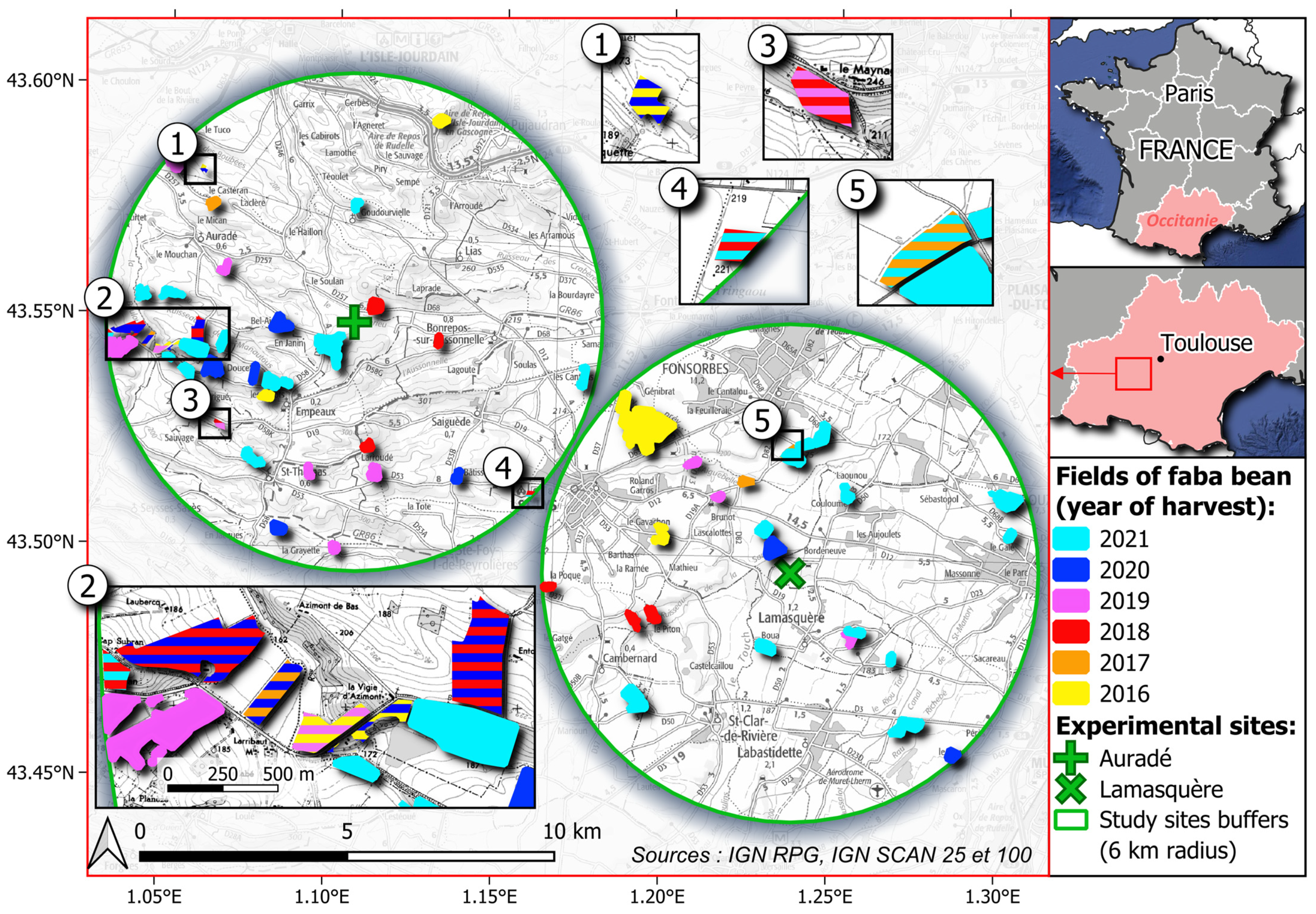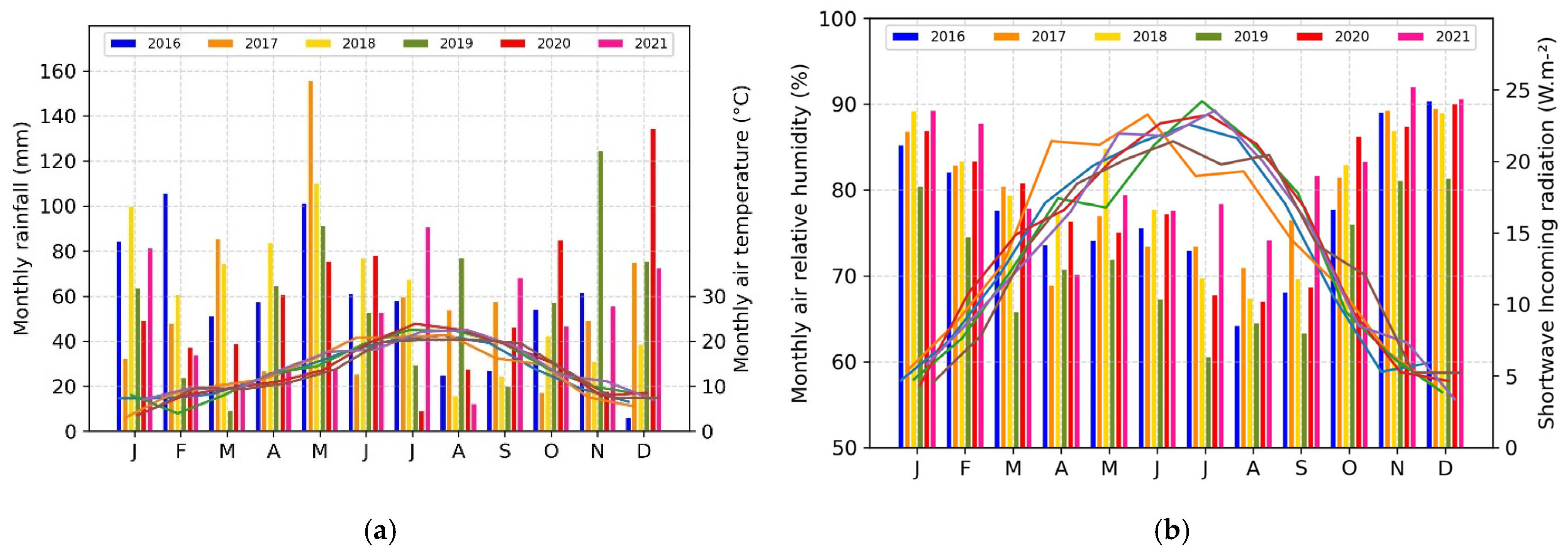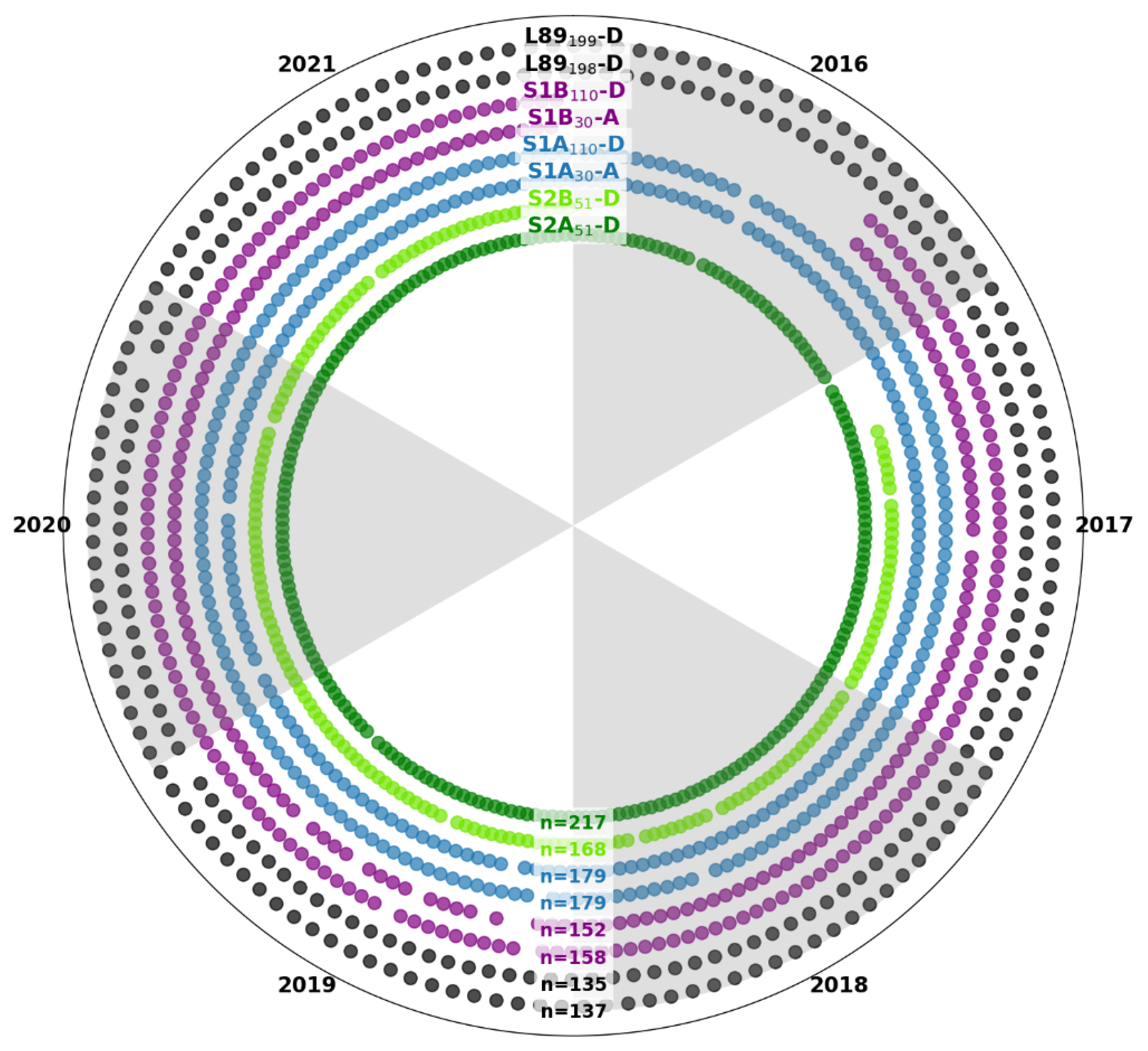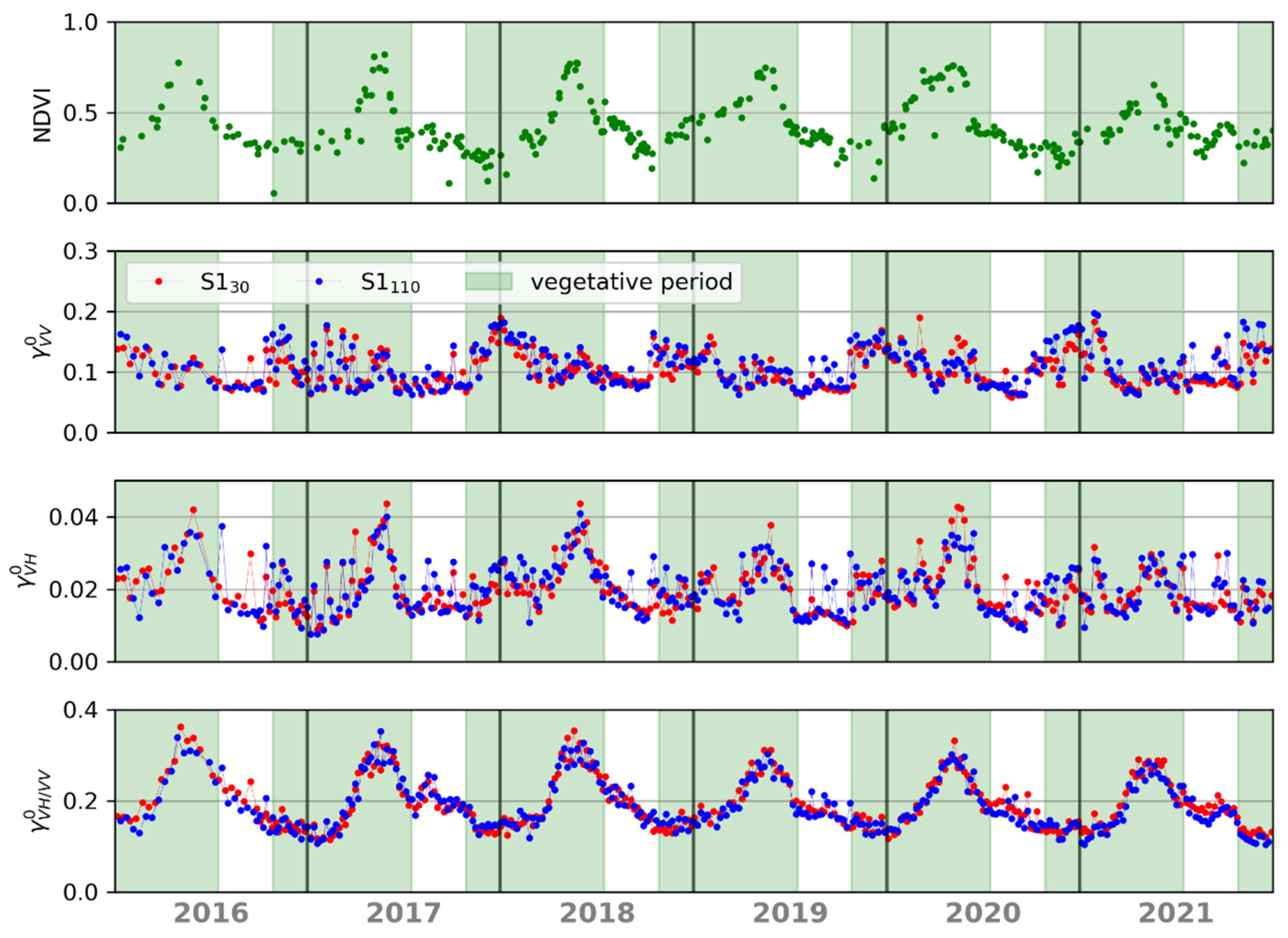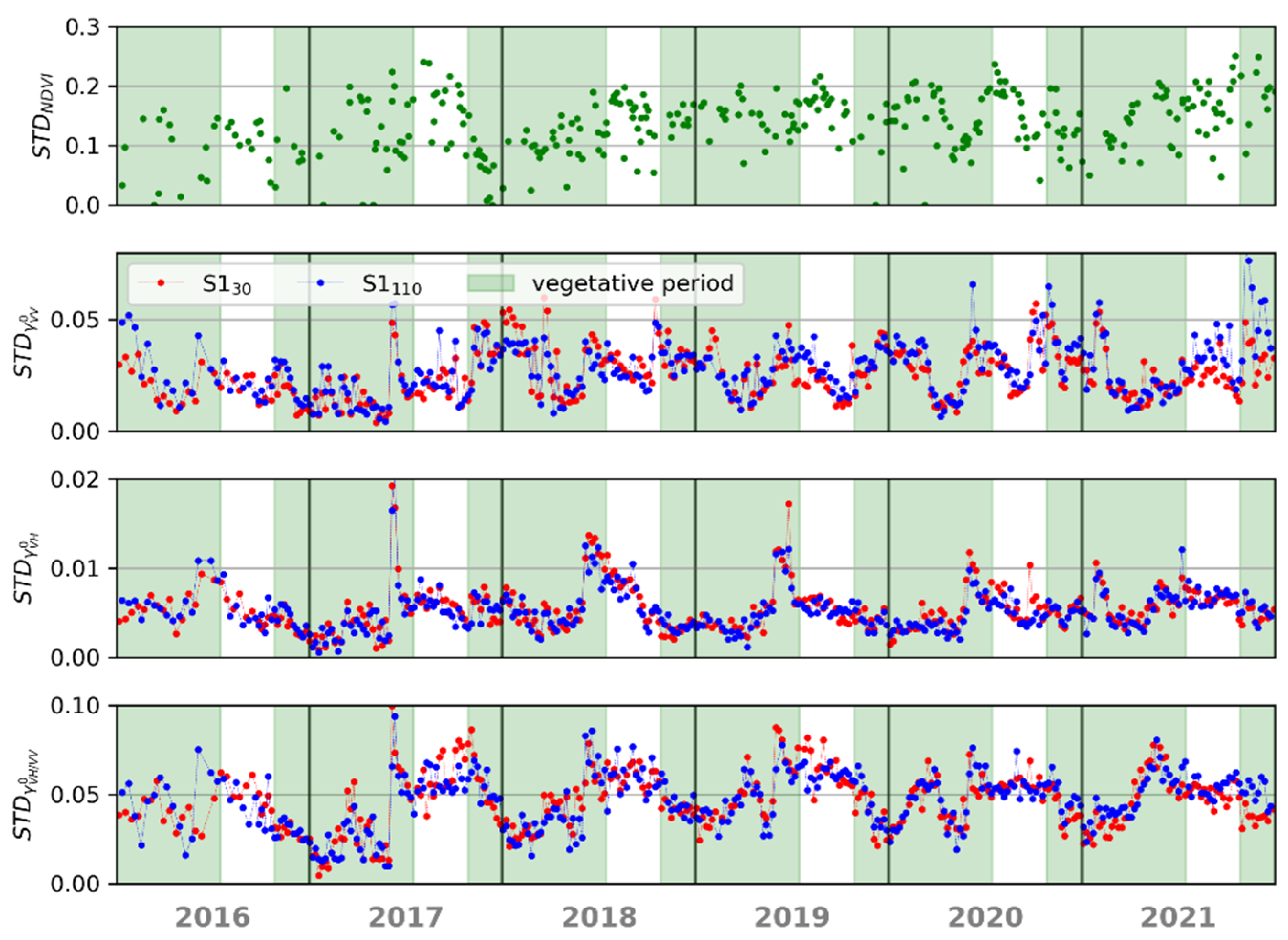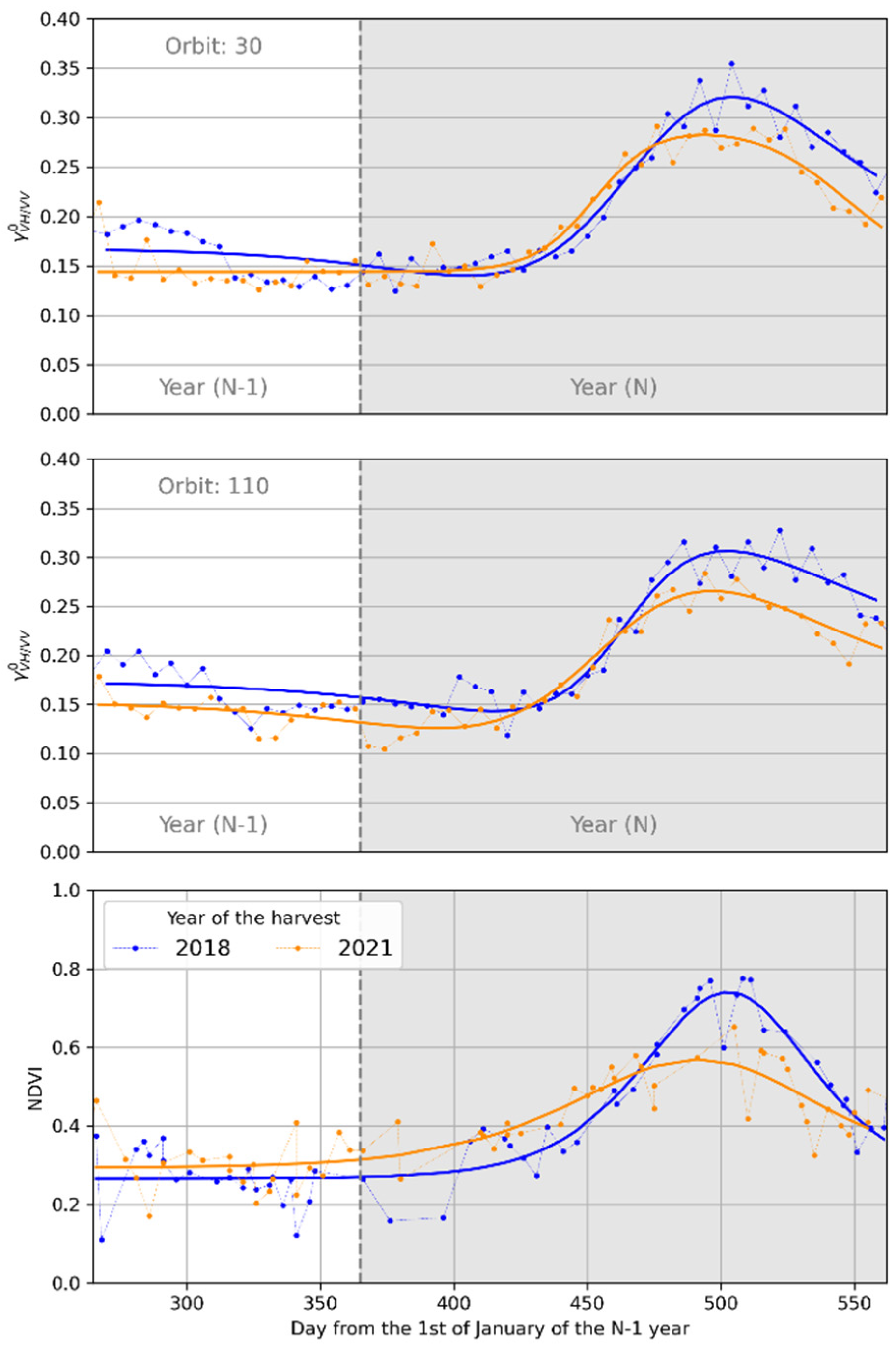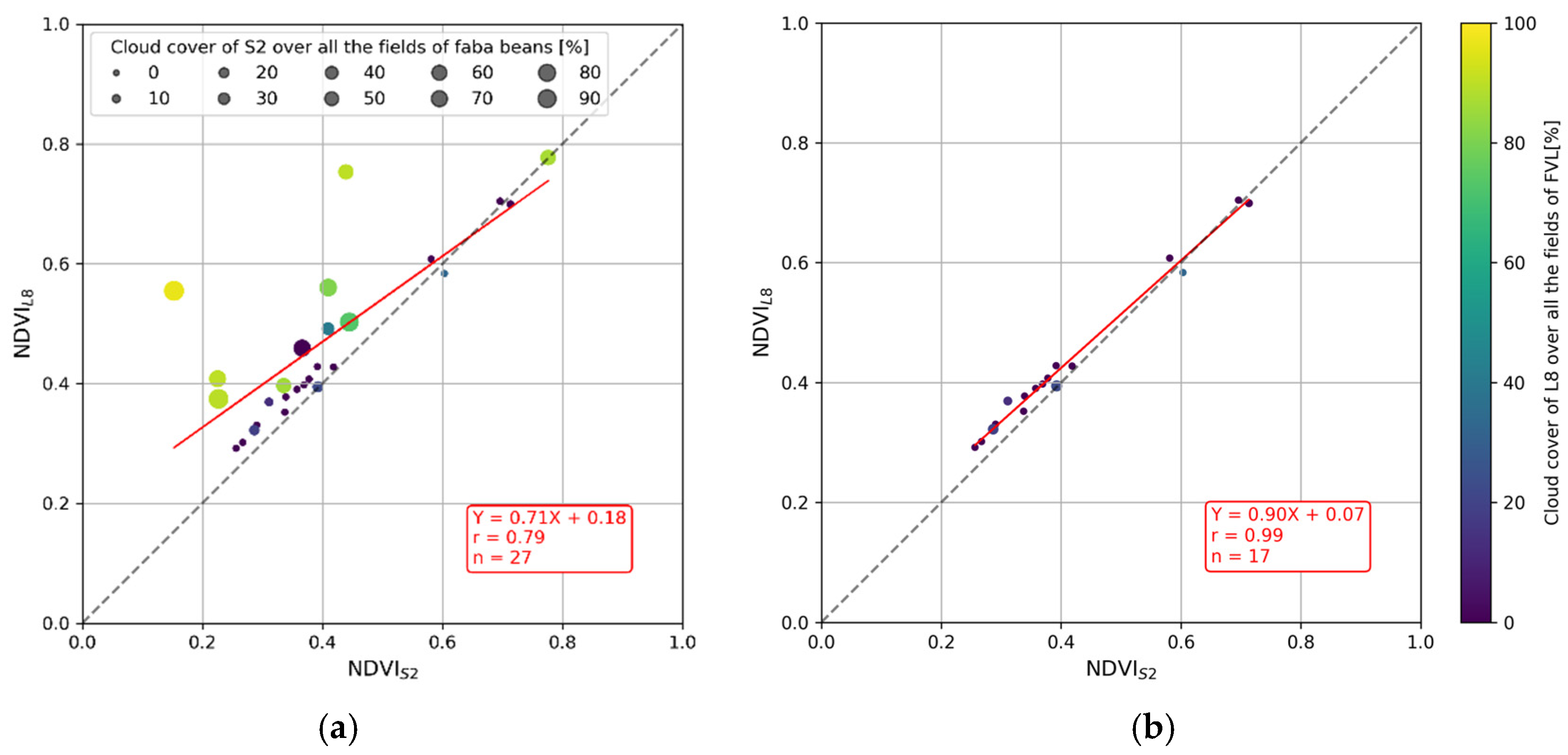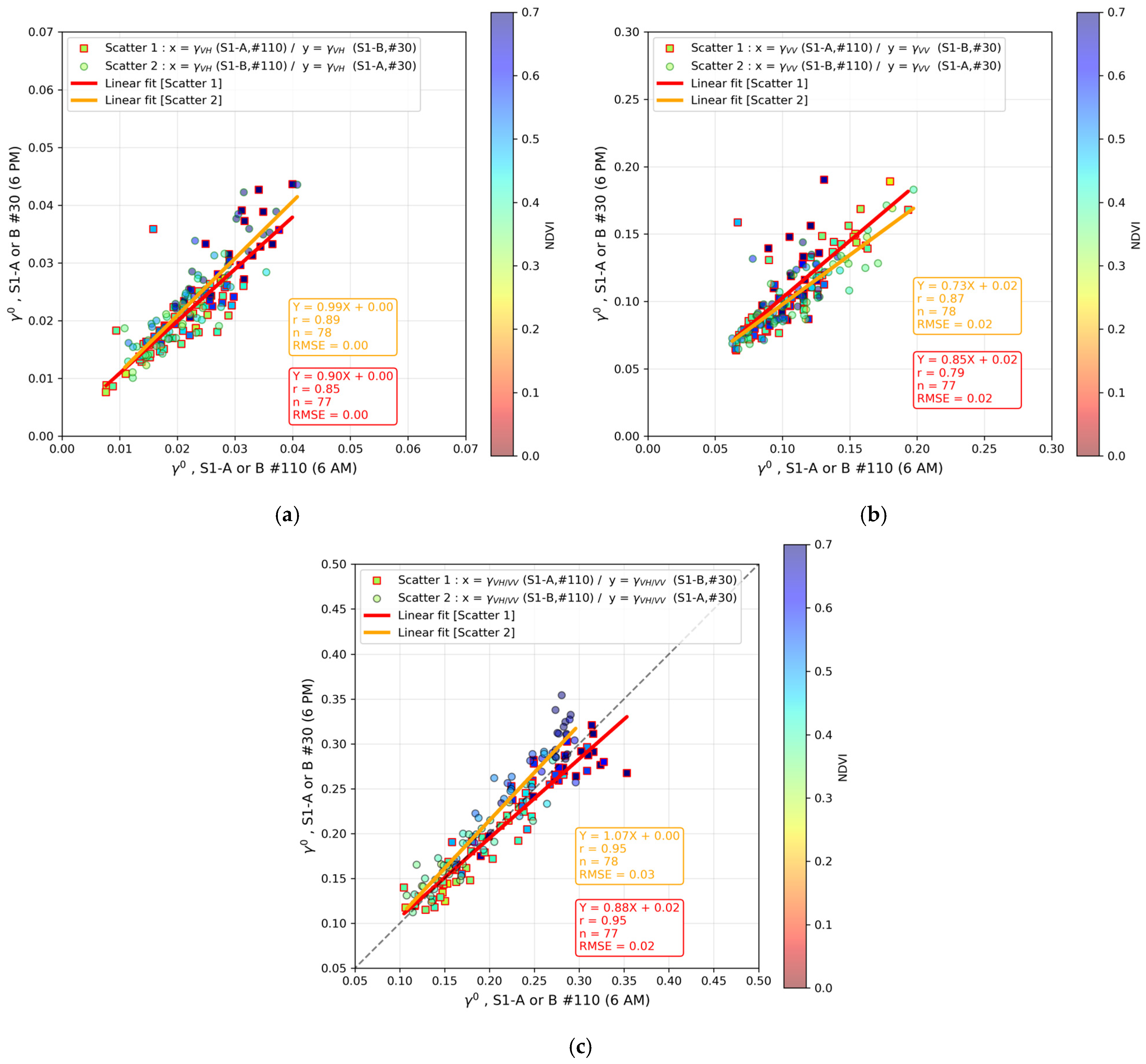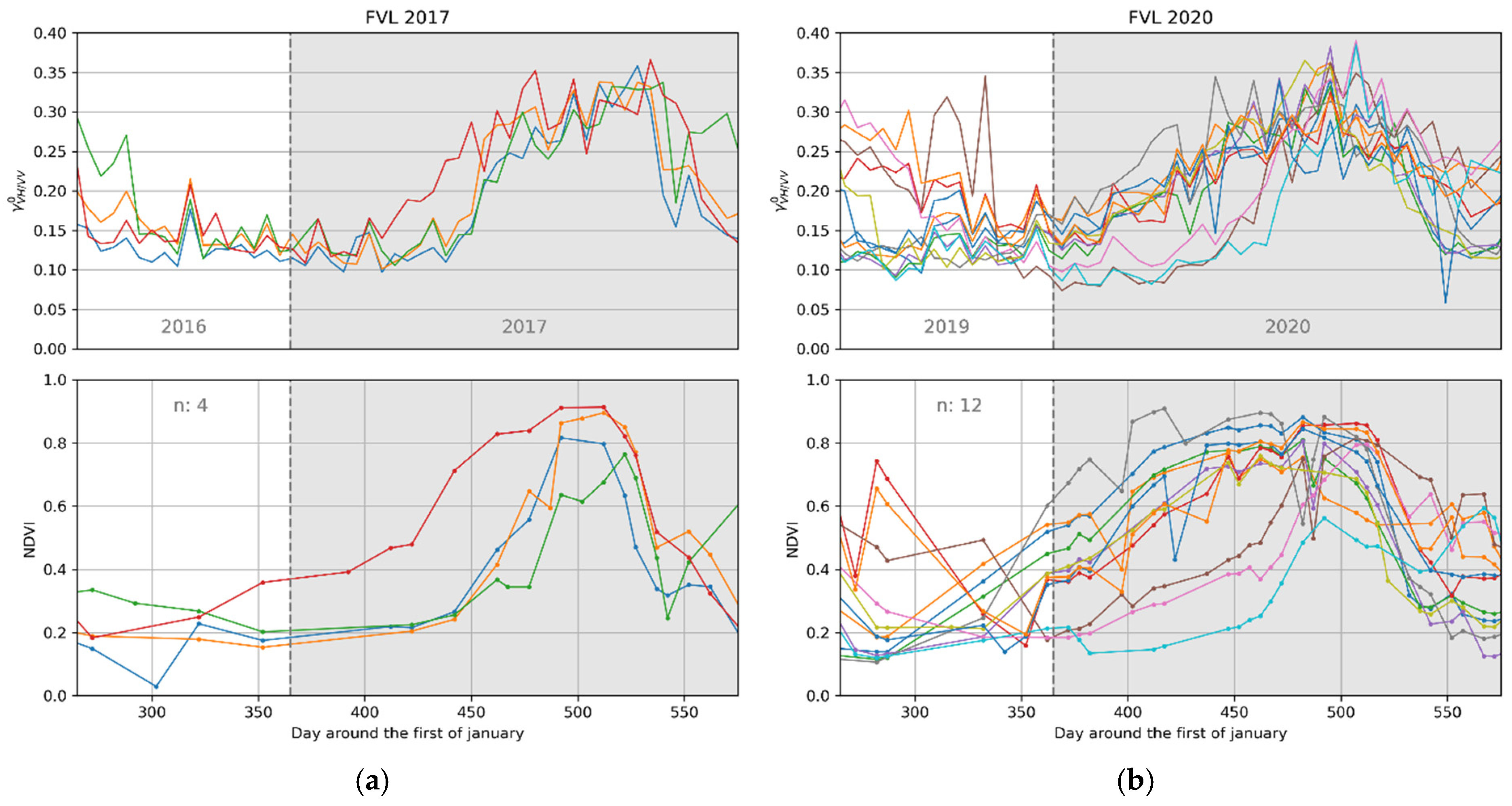1. Introduction
The faba bean (
Vicia faba L.) is a legume of major agronomic and economic importance and is cultivated worldwide due to its multiple roles [
1]. The Food and Agriculture Organization (FAO) references this crop as “Broad beans and horse beans” that are split into two classes, namely “dry” and “green”. Dry faba beans are fully ripened and dried in the field, making them ideal for long-term storage, export, and use in processed foods. In contrast, green faba beans are harvested while still fresh and tender. Unlike dry beans, green faba beans have a short shelf life. The balance between the two types depends on agricultural practices, consumer preferences, and food industry demands across different regions. Over the period from 1961 to 2023, production volumes in the “green” category more than doubled, rising from 647,212 to 1,637,887 tones (statistics available at
https://www.fao.org/faostat/en/#data/QCL (accessed on 2 March 2025)). Importantly, in terms of volume, production in the “dry” category had average volumes of around 4,290,000 tones until the 2010s, with an increase of around 30% over the last ten years, reaching 6,073,526 tones. These two classes are cultivated on every continent. In 2023, five countries supplied more than 66% of “dry” production (China, Ethiopia, the United Kingdom of Great Britain and Northern Ireland, Australia, and France), while four of the five largest “green” producing countries were located around the Mediterranean (Algeria, Egypt, Tunisia, and Morocco). Cultivated for the protein and starch content of its seeds, it is used in human and animal nutrition. Dried faba beans contain more protein, fiber, and minerals than green faba beans, which are richer in vitamins and provide more hydration [
2]. Like other legumes, faba beans have the ability to fix atmospheric nitrogen through symbiosis with nitrogen-fixing bacteria. When integrated into a cropping system, they help to diversify crop rotations, limiting the risks associated with monocultures and making farming systems more resilient to climatic hazards [
3]. They are also used as an intermediate crop, alone or in combination with other species, to reduce the dependence on chemical fertilizers and improve soil structure and fertility [
4,
5].
Due to the specificities of faba beans, their wide geographical distribution, as well as the different modes of production or use in cropping systems, the issues related to this crop are diverse. The effective monitoring of this crop over large spatial areas therefore represents a challenge, requiring advanced tools to monitor its growth, anticipate abiotic and biotic stresses, or assess the quantity of biomass produced, as well as the yields. Thanks to its instantaneous wide-angle vision, remote sensing satellite imagery (and, in particular, the combined use of optical and radar images such as those provided by the Sentinel-1/2 and Landsat satellites) offers ways of meeting these challenges [
6]. Unlike optical sensors, which are limited by weather conditions and cloud cover, microwave radar systems operate independently of cloud cover and lighting, ensuring continuous data acquisition throughout the year. Complementary to optical data (and associate derived indexes), radar images can detect fine variations in vegetation structure and soil moisture, two crucial parameters for crop monitoring. Integrating radar images into agricultural monitoring systems facilitates the early detection of water stress, the assessment of growth dynamics, and accurate crop mapping [
7]. These capabilities improve agronomic management, biomass, the leaf area index (LAI), leaf cover, plant growth, or yield prediction, providing valuable tools for optimizing the productivity and sustainability of crop-based production systems [
7,
8,
9,
10,
11,
12,
13,
14,
15,
16,
17,
18,
19]. In addition, Sentinel-1 radar imagery, with its high spatial resolution and regular acquisition frequency, enables fine, large-scale monitoring of crop fields.
To our knowledge, in the specific case of faba beans, no work has been carried out to monitor their phenology over time using satellite images. Most of the work using satellite images focuses on another legume: soybeans. For this crop, the results provide an insight into the potential of these data for monitoring this crop, particularly regarding issues of early crop mapping, the estimation of the leaf area index, or vegetation monitoring, through the assimilation of optical and SAR data in a growth model [
10,
13,
14,
15,
20]. In the case of radar data, the use of radar polarimetric signals (VV, VH, and VH/VV) provides valuable information for crop monitoring by capturing structural, biophysical, and moisture-related changes throughout development. Unlike optical data, radar backscatter arises from multiple scattering mechanisms (surface, volume, and double-bounce) depending on crop characteristics (e.g., biomass, architecture, and height) and soil conditions (e.g., moisture and roughness). At early stages, surface scattering dominates, while volume scattering from stems and leaves becomes prominent during growth, especially in VH. Double-bounce scattering, linked to vertical structures like faba bean stems, also occurs depending on the structure of the crop. The VH/VV ratio is more sensitive to the vegetation structure and moisture signals than to changes in soil moisture and incidence angle, making it a robust indicator of phenology and crop stress. Studies on soybeans (structurally similar to faba bean) confirm that cross-polarization and VH/VV correlate well with LAI and biomass, suggesting volume scattering as the dominant mechanism in such crops [
6,
10,
13,
14]. The faba bean crop is mainly studied using remote sensing images based on data acquired by unnamed aerial vehicles (UAVs). They have shown the potential of optical imagery for estimating key crop parameters such as height, phenological stages, or biomass using machine learning approaches or not [
21,
22,
23,
24]. Using optical images acquired by UAVs for large-area mapping (over several countries for example) and with dense temporal sampling (every few days) presents several limitations compared to satellite optical imagery. First, coverage and scalability are restricted, as UAVs have a limited flight range and battery duration, making them inefficient for mapping extensive regions. Second, operational constraints such as weather dependency, regulatory restrictions, and flight planning complexities make frequent data acquisition challenging. Third, data processing and storage demands increase significantly with high-resolution drone imagery, requiring more computational resources. In contrast, satellites provide long-term, consistent, large-scale, and frequent coverage without the logistical limitations and at a lower cost than drone operations. Moreover, no commercial drone acquired data in the microwave domain.
In this context, the objective of this study is to explore the capabilities of optical and radar satellite data to monitor the phenology cycle of faba beans in the southwest of France over a 6-year period between 2016 and 2021. The paper is organized as follows:
Section 2 describes the study area, while
Section 3 presents ground and satellite data. Then, the method is presented in
Section 4. Analyses of temporal evolution of optical and radar signals are presented in
Section 5.1. The ability of radar backscatter coefficients to recover NDVI or LAI is examined in
Section 5.2. The capacity to model the temporal evolution of satellite signals using double logistic (DL) fitting functions is investigated in
Section 5.3. The discussion evaluates the impact of mixing optical (
Section 6.1) and radar (
Section 6.2) data provided by different sensors (Sentinel-2, Landsat-8, and Sentinel-1), considering orbit pass, the time of acquisition (6 a.m. or 6 p.m.), or the difference in spectral bandwidth.
Section 6.3 presents an intra-annual analyses of crop development by comparing the field-by-field temporal evolution of satellite signals. In a final sub-section (
Section 6.4), the application of these results is extended to the study of faba beans used as an intercrop.
2. Study Site
The study site is located in southwestern France in the Occitanie region, which is centered at coordinates 43.52198°N, 1.17032°E (
Figure 1). The site is divided into two distinct zones represented by circles with a six-kilometer radius centered on two experimental fields: Auradé and Lamasquère, where weather stations are installed and measure air and soil climatic conditions. The study site is part of a French observatory called Regional Spatial Observatory South-West (RSO SW) and part of the Integrated Carbon Observation System (ICOS) international networks [
25,
26]. The research activities mainly focused on the monitoring and assessment of natural and anthropogenic determinants of the ecosystem functioning at a regional watershed scale and its landscape. The observatory is also part of the Pyrenees Garonne Regional Workshop Area (ZA PYGAR) and the national Research Infrastructure Critical Zone Observatories: Research and Applications (OZCAR) [
27,
28]. Moreover, the two experimental sites of Auradé and Lamasquère are part of the JECAM project (Joint Experiment for Crop Assessment and Monitoring—
https://jecam.org (accessed on 2 March 2025)). The two zones are partly occupied by urban areas, lakes, and forests (about 10% for the three land use classes). The rest of the area is composed of meadows and annual crops such as maize, sunflowers, wheat, and rapeseed (for the main crops).
Faba beans (a total 78 fields over the surveyed period,
Figure 1) are cultivated on a variable number of fields ranging from 4 in 2017 to 30 in 2021. They represent a small part of the total agricultural surface: between 0.16% and 1.56% in 2017 and 2021, respectively. The number of fields is fairly constant in other years: 9 in 2016, 11 in 2018, and 12 in 2019 and 2020. Regardless of the number of faba bean fields, the surface area under cultivation has increased in recent years (from less than 15.4 ha in 2017 to 176.5 ha in 2021). The fields’ delineation and the associated attribute table are provided by the French Services and Payment Agency (ASP). It provides a regulated anonymous version of graphical data from the French Graphical land Plot Register (RPG), associated with the data declared by the French farmers to the state. Different varieties of faba beans can be sown during 2 periods, in spring or in autumn. The French RPG does not make any distinction between sowing periods. The only available information is that the crop is sown before the 31st of May of the current year. Regardless of the sowing date, the crop is harvested in June/July.
The region is governed by a temperate climate. The Auradé field is subject to natural rainfall (about 600 mm per year on average during the study period), while Lamasquère, submitted to a similar rainfall regime, benefits from an irrigation system (pivot and reel). The mean daily air temperature is ranging from a few degrees in winter to 25 °C in summer. A six-kilometer radius was chosen to maintain proximity to the climate measurement stations while avoiding overlap between the two zones. The slope of the faba bean fields ranges between 0° (horizontal) and 12.48° (2.9° on average for all the fields). The analysis of the rotation of land use shows that most fields change from one year to the next. No field was cultivated with faba beans more than twice during the study period, and only one was cultivated for 2 consecutive years: 2018 and 2019 (zoom number 3 in
Figure 1).
4. Methodology
Figure 4 describes the method used in this study. Satellite data are firstly preprocessed as described in
Section 3.2. They are then extracted and averaged by field and by year (after applying a 15 m buffer zone to reduce mixing pixels and the field’s border effects) with respect to their shapes. Inter- and intra-annual satellite time series are then extracted for the following configurations: NDVI, γ
0VV, γ
0VH, and γ
0VH/VV. The results present an analysis of the time series of the satellite signals. The four configurations are studied through the evolution of their mean and standard deviation over time (
Section 5.1). The time series of the vegetation index (VI) that best describe the vegetation (
Section 5.2) are then modeled using the DL parametric function (Equation (1)), as already successfully applied on optical and SAR data [
39,
41,
42] (
Section 5.3). DL is driven by six metrics that are necessary to describe vegetation phenology.
where t represents the day of the year.
Indmin and
Indmax are related to the base level and amplitude of the DL, respectively.
Grin and
Sein determine the date of the inflection points during the growing and senescence periods, respectively.
Grsl and
Sesl determine the slope during the growing and senescence phases, respectively. The parametric method makes it possible to compare the vegetation monitoring potential of different satellite missions. Its application over several years enables us to characterize, compare, and analyze the dynamics observed, in relation to the agricultural practices and climatic conditions. The quality of each double logistic function is assessed by the values of the coefficient of correlation (r, Equation (2)) and the relative root mean square error (rRMSE, Equation (3)) estimated between fitting curves and satellite data. They are then used to describe vegetation inter-annual development of each crop according to precipitation and temperature information collected in situ (
Section 5.4).
where
n is the number of observed values,
o represents the observed value,
p is the predicted value, COV is the covariance, and
σo and
σp are the standard deviations of the observed and predicted data, respectively.
represents the mean of observed values.
7. Conclusions
The aim of this article was to explore the capabilities of optical and radar satellite data to monitor the phenology cycle of faba beans. To this end, a dense satellite dataset was collected for 6 years, between the beginning of 2016 and the end of 2021. The size of the satellite image dataset (585 and 671 images processed in the optical and radar domains, respectively), combined with very good knowledge of land use, topography, cloud cover, and meteorology, enabled the quantification of the climatic impact on satellite signals.
The first part of the results shows that the average temporal signatures obtained for faba beans are stable over time. The phenological cycle is perfectly identifiable, and none of the optical (NDVI) or radar (γ
0VV, γ
0VV, and γ
0VH/VV) signals are as saturated as for other legumes like soybeans, unlike many other crops (corn, sunflowers, sorghum, etc.) [
6,
7,
10]. The effects of rainfall and tillage are more visible in the co- and cross-polarization radar signals. The two best indices for monitoring phenology are NDVI and γ
0VH/VV. The latter correlates well with NDVI (r = 0.81) and LAI (r = 0.83), especially in orbit 30, where the higher incidence angle provides greater sensitivity to vegetation development. The detailed study at the inter-field scale highlights the disparity of the temporal signatures, which is not visible when studying the average of the temporal signatures. This allows for the identification of agricultural practices, with an emphasis on autumn and spring sowing. Anomalies in plant development are also visible as a function of climatic conditions and/or farming practices. The study of a field of faba beans grown as an intercrop highlighted the similarities and differences between this practice and the use of faba beans as a cash crop sown in autumn or spring. With a sowing similar to that of winter faba beans, plant development is much faster (role of the seed). This is the only case where the NDVI signal saturates early during the growing period. The time of destruction is notable and occurs a few months before the traditional harvest at the end of June. These behaviors are clearly visible on both the NDVI and γ
0VH/VV temporal signals.
The second part of the results shows that the modeling of temporal signatures using double logistic functions is suitable for this crop. The modeling of the γ0VH/VV signal (for orbits 30 and 110) is excellent, with mean relative errors between years less than 9% and correlation coefficients greater than or equal to 0.95. The quality of the NDVI models is slightly less good (rmean = 0.89 and rRMSEmean = 14.91%) but remains sufficient to accurately describe the phenological cycle of the faba bean. This degradation is linked to certain atmospheric conditions: clouds and their shadows, which are not always well detected, interfering with the measurement of NDVI. The inter-annual comparison of the double logistics obtained over the period of 2016–2021 allowed for the definition of average annual envelopes for the phenology trajectory of faba beans. These envelopes can serve as a reference in the literature for the annual study of faba bean phenology in the coming years as part of an operational approach to real-time monitoring. Moreover, the intra-annual results demonstrate how satellite time series can be used to refine and enhance phenological monitoring (between autumn versus spring crop sowing), especially in contexts where administrative data are incomplete or imprecise (like those provided by the French RPG).
The results of this study demonstrate the usefulness of multiwavelength and multi-remotely sensed observations, which can be used together or separately for monitoring and modelling the temporal evolution of faba bean phenology. In light of this study, it would be interesting to test this method over other land uses. It would also be interesting to apply the method on other SAR data, such as those offered by TerraSAR-X (X-band), Cosmos-Skymed (X-band), or ALOS-2 (L-band) and NISAR (S and L bands) and Biomass (P-band) in the near future. Future work could also integrate scattering models to further strengthen the interpretation of the temporal evolution of the SAR signal.
